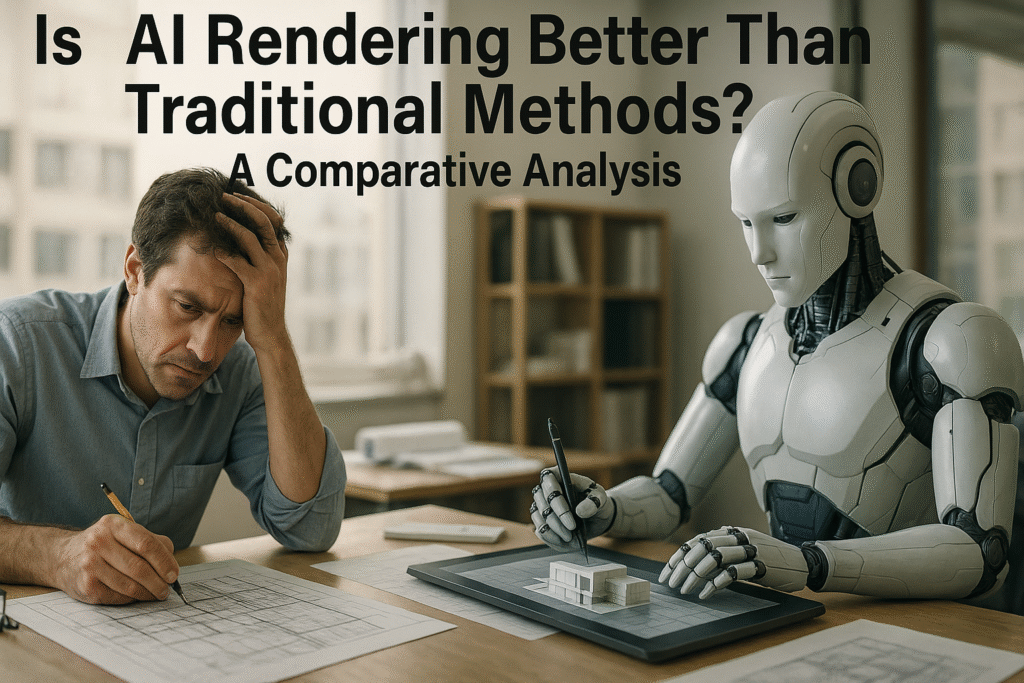
Introduction
In our fast‑paced world, visuals matter more than ever. Rendering—bringing digital scenes to life—is no exception. But which method truly delivers? AI rendering or traditional painstaking techniques? It’s a question buzzing in design studios, game houses, film sets and construction firms. Let’s explore this with fresh eyes and emotional impac
What is Traditional Rendering?
Traditional rendering uses tried‑and‑tested methods like ray tracing, path tracing, and rasterization. It involves precise Maths and physics:
Engineers set up light sources.
Artists tweak textures.
Frames are calculated pixel by pixel—slowly but with high accuracy.
This method is reliable, trusted and consistent. But it can be incredibly time‑consuming.
Real‑life example: A film VFX team might take hours to render a single shot with photo real lighting. A minor tweak, and it’s back in the queue. Painful.
AI Rendering: The New Kid on the Block
AI rendering uses machine learning to automate parts of the process. For instance:
Denosing: Clean up noisy renders quickly.
Frame Interpolation: Predict missing frames (e.g. NVIDIA DLSS).
Scene Analysis: AI picks optimal lighting and composition.
Real‑life example: Architects can now push a button and get a photo real image in minutes—not hours.
AI speeds things up. It lowers hardware demands. It handles the boring bits. But is speed king?
AI vs Traditional: Head‑to‑Head
| Feature | Traditional Rendering | AI Rendering |
| Speed | Slow and meticulous | Fast and efficient |
| Quality & Control | High precision, full control | Good, but sometimes lacks subtlety |
| Cost | Heavy GPU/CPU demand; time = money | Less compute, shorter timelines |
| Creativity | Artist‑driven nuance and emotion | Predictive, less emotional sometimes |
| Reliability | Exhaustive physics = predictable results | Can be unpredictable; needs oversight |
Real‑life feeling: Traditional rendering is like crafting a portrait—painstaking but full of soul.
AI rendering is like an instant filter—it’s quick but sometimes a bit flat.
? When AI Wins
Speed‑crucial projects
Game previews on a deadline.
Real‑estate walkthroughs for property sales.
Architect Kudless reflects: AI allows early client visuals and better emotional buy‑in
Big pipelines
AI denoising (e.g. DLSS) speeds workflows immensely.
Tight budgets
Lower hardware needs, fewer artist hours.
Iterations
AI helps when many “quick‑look” drafts are needed—without waiting days.
❗ Where Traditional Still Rules
Absolute accuracy
If every light reflection must obey physics, go classic.
Creative nuance
A skilled artist can tell a story in a single image. AI doesn’t feel.
Final film or premium ads
Expect full‑render pipelines and manual polish.
Large‑scale scene control
Traditional pipelines scale better for extremely big, detailed environments.
The Hybrid Sweet Spot
Guess what? You don’t need to choose one or the other. A smart combo works:
Start with AI: draft fast, explore ideas.
Refine with traditional: bring soul and precision.
Add AI tools mid‑pipeline: use de-noising, frame‑generation, scene‑analysis.
This blend gives speed, emotion and quality.
Real‑Life Hybrid Success
Case Study: An interior design firm used D5 Render’s AI for early proofs.
They then polished top scenes with traditional software. Result? They saved hours—and clients loved the visuals.
Case Study: A VFX house used NVIDIA DLSS 4.0 to cut GPU time, then finished shots with ray tracing.
Emotional Appeal & Human Touch
Quality visuals aren’t just about pixels. They stir feelings.
A warm living‑room render makes you sigh “Home.”
A sleek car advert feels elite.
AI gives speed and polish but can miss emotional resonance. Human artists add that spark. The romance. The heart.
Conclusion
Is AI rendering better than traditional methods? Yes—and no.
AI excels in speed, efficiency, big pipelines and quick feedback.
Traditional wins in exacting quality, creative depth and fine art direction.
The best approach? Hybrid. Use AI to explore, speed up and optimize. Then let traditional rendering finish the story.
That’s the future: the perfect balance of technology and humanity.
Frequently Asked Questions
Q1: Can AI fully replace traditional rendering?
A: Not yet. Empirical evidence shows AI still lacks the subtle precision of traditional photorealism.
Q2: How much faster is AI rendering?
A: AI‑powered tools like DLSS can reduce render times by over 50%, sometimes even 80%.
Q3: Which industries benefit most?
A: Architecture, real‑estate, game dev, VFX and product design—anywhere rapid iterations matter.
Q4: Is AI rendering cheap?
A: Hardware‑wise, yes. But quality still demands talented artists and oversight.
Q5: Will AI get better?
A: Definitely. ML models and GPU tech are improving daily. But human taste still has the edge.
“Imagine wow‑factor visuals in minutes—not hours.”
“Feel‑good designs that stir hearts…and sell faster.”
“Beat deadlines. Maintain beauty. Keep your soul.”
Final Thoughts
In 2025, rendering is not a choice of old vs new. It’s a symbiosis.
AI brings speed and efficiency.
Traditional brings heart and mastery.
Together, they create visuals that wow, engage and endure.
That’s the future of rendering. And you’re already in it.
“Feel‑good designs that stir hearts…and sell faster.”
“Beat deadlines. Maintain beauty. Keep your soul.”ood designs that stir hearts…and sell faster.”
“Beat deadlines. Maintain beauty. Keep your soul.”
